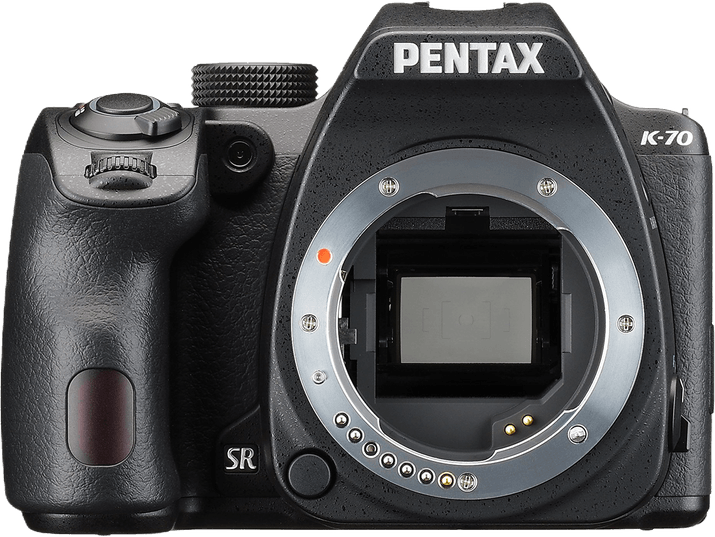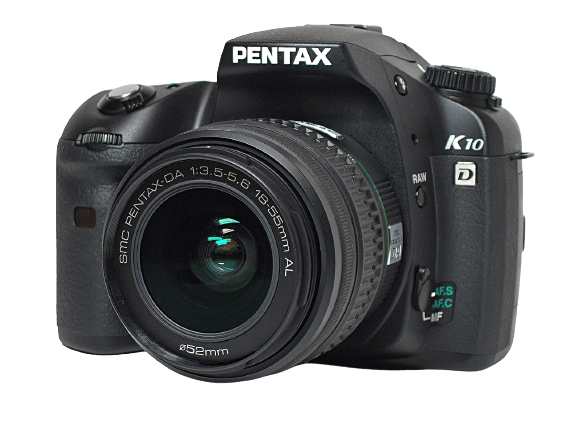Pentax K-70 vs K10D Comparison
Pentax K-70

Pentax K10D

The Pentax K-70 outperforms the Pentax K10D with a score of 69/100 compared to 40/100. Both cameras share the DSLR type and have similar dimensions, with the K-70 being slightly smaller at 126 x 93 x 74mm and lighter at 688g. The K-70 surpasses the K10D with its more recent release in 2016 and a lower launch price of $650.
Despite the older release in 2006 and higher launch price of $900, the K10D maintains a larger size at 142 x 101 x 70mm and heavier weight at 793g. However, the K-70’s higher score, smaller size, and lighter weight make it a better choice for photographers looking for an efficient and budget-friendly DSLR camera.
Pentax K-70 vs K10D Overview and Optics
The Pentax K-70 emerges as the winner in the optics comparison, with a score of 74/100, outperforming the Pentax K10D, which scored 46/100. Both cameras share some common specifications, such as sensor size (APS-C), lens mount (Pentax KAF for K10D and Pentax KAF2 for K-70), and image stabilization.
The K-70’s superior performance is evident in several aspects. It has a higher megapixel count (24) compared to the K10D (10), allowing for more detailed and higher resolution images. The K-70 also has a faster shooting speed (6) than the K10D (3), which is beneficial for capturing fast-moving subjects or continuous shooting. Furthermore, the K-70 features a CMOS sensor and a Prime MII processor, resulting in a higher DXOMARK score of 88 for its sensor. In contrast, the K10D has a CCD sensor and a Prime processor, with a DXOMARK score of 66.
Despite its lower score, the K10D has some advantages. The older lens mount, Pentax KAF, may be more compatible with a wider range of lenses, including older and more affordable options. This could be a plus for photographers on a budget or those with an existing collection of Pentax KAF lenses.
Considering the points above, the Pentax K-70 is the better option for those seeking higher image quality, faster shooting speed, and a more advanced sensor. The K10D, while inferior in these aspects, may be more suitable for those prioritizing lens compatibility and affordability. Ultimately, the choice between the two cameras depends on the individual’s needs and preferences.
Pentax K-70 vs K10D Video Performance
When comparing the video capabilities of the Pentax K-70 and the Pentax K10D, it becomes apparent that the K10D does not have any video functionality. This fact sets the two cameras apart in terms of their versatility and potential uses.
The Pentax K-70, on the other hand, offers a range of video features that make it suitable for capturing high-quality footage. With a video score of 70 out of 100, the K-70 proves to be a reliable choice for those seeking both photography and video capabilities. Its maximum video resolution is Full HD, providing clear and detailed visuals at dimensions of 1920 x 1080 pixels. The camera also supports a maximum video frame rate of 60 frames per second, allowing for smooth and fluid motion capture. Additionally, the K-70 has built-in time-lapse functionality, enabling users to create stunning time-lapse sequences with ease.
Taking into account these differences in video capabilities, it is evident that the Pentax K-70 is the more versatile option of the two cameras. While the Pentax K10D may still be a suitable choice for photographers who do not require video functionality, those seeking a camera with both photo and video capabilities will find the Pentax K-70 to be a more fitting choice.
Pentax K-70 vs K10D Features and Benefits
The Pentax K-70 outperforms the Pentax K10D with a feature score of 68/100 compared to the K10D’s 28/100. Despite the difference in scores, both cameras share some common specifications. Neither camera has a touchscreen, and both have the same lens mount (Pentax KAF2).
The K-70 surpasses the K10D in several areas. It has a larger screen size of 3 inches, compared to the K10D’s 2.5 inches. The K-70 also boasts a higher screen resolution of 921,000 dots, while the K10D has a resolution of 210,000 dots. The K-70 features a flip screen, allowing for more versatile shooting angles, while the K10D lacks this capability. Additionally, the K-70 comes with GPS, WIFI, and Bluetooth, making it more connected and convenient for modern photographers.
On the other hand, the K10D has few advantages over the K-70. It is an older model, and its lower score reflects its outdated specifications. The K10D may appeal to photographers who prefer a simpler camera or those on a tight budget, as it is likely to be more affordable than the K-70.
Based on the comparison, the Pentax K-70 is the superior camera in terms of features. It offers a larger screen, higher resolution, flip screen, and enhanced connectivity options with GPS, WIFI, and Bluetooth. The K10D, while lacking in advanced features, may still be a viable option for those seeking a basic camera at a lower price point. The K-70’s higher score of 68/100 confirms its superiority and makes it the clear winner in this comparison.
Pentax K-70 vs K10D Storage and Battery
The Pentax K10D outperforms the Pentax K-70 in storage and battery with a score of 27/100 compared to the K-70’s 24/100. Both cameras share similarities, including one memory card slot and no USB charging option. They support SD and SDHC memory cards, but the K10D also accepts MMC cards, providing more storage options.
The K10D has a longer battery life, offering 500 shots per charge, as opposed to the K-70’s 410 shots. This advantage makes the K10D more suitable for extended shooting sessions. However, the K-70 supports the faster UHS-I compatible SDXC cards, allowing for quicker file transfer and storage.
Despite the K10D’s higher score in this category, the K-70’s faster storage option could be more valuable for some users. Ultimately, the choice between these cameras depends on individual preferences for battery life and storage capabilities.
Pentax K-70 vs K10D – Our Verdict
Are you still undecided about which camera is right for you? Have a look at these popular comparisons that feature the Pentax K-70 or the Pentax K10D:

